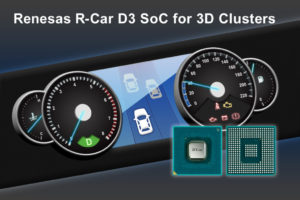Renesas Electronics, a premier supplier of advanced semiconductor solutions, has announced its high-performance R-Car D3 automotive infotainment system system-on-chip (SoC), designed to expand the use of 3D graphics instrument clusters (3D clusters) that support 3D graphics displays in entry-class cars. The R-Car D3 achieves both high-performance graphic capabilities and contributes to significant reduction in overall system development cost.
 The new SoC includes a high-performance 3D graphics core that enables a high-quality 3D display and lower system costs equivalent to the bill of materials (BOM) costs of developing with 2D graphics instrument clusters (2D clusters).
The new SoC includes a high-performance 3D graphics core that enables a high-quality 3D display and lower system costs equivalent to the bill of materials (BOM) costs of developing with 2D graphics instrument clusters (2D clusters).
By adopting the R-Car D3, system developers can re-use their 3D graphics development assets, including software and graphics designs from high-end vehicles that adopt high-performance R-Car H3 or R-Car M3 SoCs to entry-level cars. This scalability enables development of easy-to-use and high visibility entry cluster 3D graphics at approximately the same level cost as the existing 2D clusters. In addition, Renesas collaborates with industry-leading partners in the instrument cluster field to further reduce development steps and costs.
“Full graphics cluster systems equipped with a large thin filter transistor panel are expected to become mainstream for future vehicles, which will require high-definition 3D graphics display at a high speed to accurately convey information to the driver,” said Toshiaki Ichihashi, managing officer, Engineering Headquarters, Nippon Seiki Co., Ltd. “We are excited that the R-Car D3 will respond to this need as well as reduce BOM costs.”
“For more than a decade, automotive OEMs and Tier 1s have relied on BlackBerry QNX to deliver world-class software solutions for infotainment, telematics, and instrument cluster systems,” said Grant Courville, senior director of product management at BlackBerry QNX. “The combination of the new R-Car D3 SoC and BlackBerry’s ISO 26262 ASIL B-certified QNX Platform for Instrument Clusters will enable our customers to confidently deliver state-of-the-art, safety-certified digital clusters rapidly to the market.”
“The safe and secure INTEGRITY real-time operating system is widely used for automotive in-vehicle infotainment and instrument clusters in productions programs around the globe. Our support for the R-Car D3 builds on years of successful partnership with Renesas and their other R-Car devices, providing the customer with certified automotive safety, time-savings development tools, and optional virtualisation for Linux,” said Matt Slager, director of Asia-Pacific Business Development at Green Hills Software. “We see this third-generation R-Car D3 as a valuable addition to the R-Car Family of SoCs, enabling customers to easily migrate and reuse existing R-Car and INTEGRITY software assets for faster time to market for their next-generation integrated cockpit designs.”
“For practical implementation of autonomous driving, the instrument cluster needs to instantly, accurately, and safely report a wide variety of information to the driver. The Renesas R-Car D3, which provides powerful graphics capabilities and critical functional safety features for instrument clusters, is expected to revolutionise the 3D cluster user experience,” said Lynwood Stanley, vice president of Global Engineering Services at Altia. “Altia is using our DeepScreen code generator, which optimises the HMI code, for the Renesas R-Car with the goal to deliver the highest-performance embedded HMIs to the market.”
“For instrument clusters based on large-scale LCD displays, the market is expected to grow rapidly in the future, and it would be a great benefit to the customer to be able to implement such instrument clusters at a low BOM cost,” said Rock Yang, vice president at Thundersoft. “As one of the leading provider of UI/UE and OS technology, we at Thundersoft provide both software system integration and our HMI tool “Kanzi” for the R-Car including the new R-Car D3. We believe we can work with Renesas to drive the R-Car solutions market.”
The increasing number of connections between the instrument cluster and the various sensors and control devices allows more information about the vehicle and its surroundings to be captured and displayed on the instrument cluster. However, this increases the need for improved visibility from a safety point of view.
Currently, entry-class vehicles feature mostly 7- to 10-inch liquid crystal displays (LCDs) that support mainly 2D graphics. In the future, advancements in automotive LCDs size, resolution, and prices will support an anticipated explosive demand in 3D clusters to meet the growing need for clearer and highly visible designs on a large screen, particularly in the Chinese market.
In the meantime, system developers working with automotive instrument clusters must manage an increasing number of development steps and costs, as 3D clusters for entry-class cars are required to meet both the strict cost and high-performance as existing 2D clusters but with 3D graphics drawing requirements.
Renesas developed the R-Car D3 with these functions and performance capabilities in mind, offering developers a reliable, robust 3D clusters solution that is scalable from entry-level to high-end vehicles.
 CIE Components in Electronics
CIE Components in Electronics



